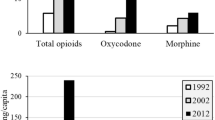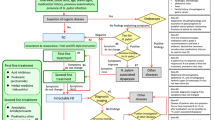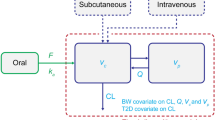Abstract
Functional 5-HT4 receptors have been reported to be present in numerous isolated tissue preparations including the rat oesophagus, guineapig ileum, and human colon. The pharmacological properties of the novel, potent and selective 5-HT4 receptor antagonists SB203186 (1-piperidinyl)ethyl 1H-indole 3-carboxylate, SB205008 (1-butyl-1-methyl4-piperidinylmethyl)-8-amino-7-chloro-1,4-benzodioxan-5-carboxylate iodide, and SB207710 (1-butyl-4-piperidinylmethyl)-8-amino-7-iodo-1,4 benzodioxan-5-carboxylate) were studied in these tissues. The nature of antagonism of the 5-HT-induced effects was investigated on the above isolated tissue preparations.
5-HT produced its effect with the following EC50 values: 400 ± 0.4 nM (rat oesophagus, n = 20), 154 ±14 nM (guinea-pig ileum, n = 9) and 144 ± 0.1 nM (hu man colon, n = 9). SB207710 (0.03–1 nM), SB205008 (1.0–10 nM), and SB203186 (10–100 nM) antagonised the 5-HT4 receptor-mediated relaxations of the carbachol-contracted rat isolated oesophagus against 5-HT with pKB values of 10.9 ± 0.1, 9.5 ± 0.1, and 9.0 ± 0.1 respectively without effecting the maximum response. On the guinea-pig ileum peristaltic reflex preparation, SB207710 (0.01–1 nM) did not modify the reflex but it behaved as an antagonist of the 5-HT-induced facilitation with a pA2 value of 9.9 ± 0.2. The agonists DAU 6236 (endo-8-methyl-8-azabicyclo [3.2.1] oct-3-yl 2,3-dihydro-3-ethyl-2-oxo-1H-benzimidazole-1-carboxylate hydrochloride) at 2 μM, and SC 53116 (1-S,8-S)-4-amino-5-chloro-N- [(hexahydro-1H-pyrrolizin-1-yl)methyl]-2-methoxy-benzamide hydrochloride at 500 nM facilitated the peristaltic reflex. SB207710 (0.25–5 nM), SB205008 (1–100 nM) and SB203186 (10–1000 nM) failed to modify the spontaneous activity of the circular muscle of the human colon, but caused parallel, dextral shifts in the concentration-effect curves to 5-HT with apparent pKB values of 10.0 ± 0.3 (0.25 nM), 9.8 ± 0.2 (1 nM), and 8.6 ± 0.3 (10 nM) respectively. Higher concentrations of each antagonist shifted the concentration-effect curves to 5-HT to the right but this antagonism did not appear to be simple competitive. Methysergide (10 μM) and ondansetron (10 μM) increased the activity of SB207710 (5 nM) in the human colon giving rise to a 4 point (0.25, 0.5, 1,5 nM) Schild slope not significantly different from unity and a pKB of 10.1 ± 0.1. Cocaine (30 μM). did not significantly affect the activity of SB207710.
The compounds SB207710, SB205008 and SB 203186 were shown to be high affinity 5-HT4 receptor antagonists. SB207710 is the most potent 5-HT4 receptor antagonist described so far and as such, is a potentially useful tool for 5-HT4 receptor characterisation in functional studies of tissue from man and other species.
Similar content being viewed by others
References
Akbarali HI, Beiger D, Triggle CR (1987) Effects of cold storage on relaxation responses in the rat oesophageal tunica muscularis mucosae. Can J Physiol Pharmacol 65:23–29
Arunlakshana O, Schlid HO (1959) Some quantitative uses of drug antagonism. Br J Pharmacol Chemother 14:48–58
Baxter GS, Craig DA, Clarke DE (1991) 5-Hydroxytryptamine4 receptors mediate relaxation of the rat oesophageal tunica muscularis mucosae. Naunyn Schmiedeberg's Arch Pharmacol 343:439–446
Bockaert J, Fozard JR, Dumuis A, Clarke DE (1992) The 5-HT4 receptor: a place in the sun. Trends Pharmacol Sci 13:141–145
Borman RA, Burleigh DE (1994) Heterogeneity of 5-HT receptors in human sigmoid colon. Br J Pharmacol 112:558P
Brown AM, Youn TJ, Patch TL, Cheung CW, Kaumann AJ, Gaster L, King FD (1993) [125I]-SB207710, a potent, selective radioligand for 5-HT4 receptors. Br J Pharmacol 110:10P
Buchheit K-H, Buhl T (1991) Prokinetic benzamides stimulate peristaltic activity in the isolated guinea-pig ileum by activation of 5-HT4 receptors. Eur J Pharmacol 205:203–208.
Buchheit K-H, Buhl T (1993) 5-HT receptor subtypes involved in the stimulatory effect 5-HT on the peristaltic reflex in vitro. J Gastrointest Mot 5:49–55
Buchheit KH, Gamse R, Pfannkuche HJ (1992) SDZ 205–557, a selective, surmountable antagonist for 5-HT4 receptors in the isolated guinea-pig ileum. Naunyn Schmiedeberg's Arch Pharmacol 345:387–393
Bülbring E, Crema A (1958) Observations concerning the action of 5-hydroxytryptamine on the peristaltic reflex. Br J Pharmacol 13:444–457
Costall B, Naylor RJ, Tuladhar BR (1993) 5-HT4 receptor mediated facilitation of the emptying phase of the peristaltic reflex in guinea-pig isolated ileum. Br J Pharmacol 110:1572–1578
Craig DA, Clarke DE (1990) Pharmacological characterisation for a neuronal receptor for 5-hydroxytryptamine in guinea-pig ileum with properties similar to the 5-HT4 receptor. J Pharmacol Exp Ther 252:1378–1386
Craig DA, Clarke DE (1991) Peristalsis evoked by 5-HT and renzapride: evidence for a putative 5-HT4 receptor activation. Br J Pharmacol 102:563–564
Dumuis A, Bouhelal R, Sebben M, Bockaert J (1988a) A 5-HT receptor in the central nervous system, positively coupled with adenylyl cyclase, is antagonised by ICS 205–930. Eur J Pharmacol 146:187–188
Dumuis A, Bouhelal R, Sebben M, Cory R, Bockaert J (1988b) A nonclassical 5-hydroxytryptamine receptor positively coupled with adenylate cyclase in the central nervous system. Mol Pharmacol 34:880–887
Dumuis A, Sebben, Bockaert J (1989) The gastrointestinal prokinetic benzamide derivatives are agonists at the non-classical 5-HT receptor (5-HT4) positively coupled to adenylate eyelase in nuerons. Naunyn Schmiedeberg's Arch Pharmacol 340:403–410
Elswood CJ, Bunce KT, Humphrey PPA (1991) Identification of putative 5-HT4 receptors in guinea-pig ascending colon. Eur J Pharmacol 196:149–155
Flynn DL, Zabrawski DL, Becker DP, Nosal R, Villamil CI, Gullikson GW, Moummi C, Yang D (1992) SC-53116: The first selective agonist at the newly identified serotonin 5-HT4 receptor subtype. J Med Chem 35:1486–1489
Fozard JR, Ali ATMM, Newgrosh G (1979) Blockade of serotonin receptors on autonomic neurones by (−)-cocaine and some related compounds. Eur J Pharmacol 59:195–210
Gale JD, Grossman CJ, Whitehead JWF, Oxford AW, Bunce KT, Humphrey PPA (1994) GR 113808: a novel, selective antagonist with high affinity at the 5-HT4 receptor. Br J Pharmacol 111:332–338
Gaster LM, Jennings AJ, Joiner GF, King FD, Mulholland KR, Rahman SK, Starr S, Wymann PA, Wardle KA, Ellis ES, Sanger GJ (1993) (1-Butyl-4-piperidinyl) methyl 8-Amino-7-chloro-1,4-benzodioxane-5-carboxylate hydrochloride: A highly potent and selective 5-HT4 receptor antagonist derived from metoclopramide. J Med Chem 36:4121–4123
Hillier K, Tam FS-F, Bunce KT, Grossman C (1994) Inhibition of motility induced by the activation of 5-HT1 and 5-HT4 receptor types in isolated human colon smooth muscle. Br J Pharmacol 112:102P
Hoyer D, Clarke DE, Fozard JR, Hartig PR, Martin GR, Mylecharane EJ, Saxena PR, Humphrey PPA (1994) International Union of Pharmacology classification of receptors for 5-hydroxytryptamine (serotonin). Pharmacol Rev 46:157–204
Kaumann AJ, Sanders L, Brown AM, Murray KJ, Brown MJ (1990) A 5-hydroxytryptamine receptor in human atrium. Br J Pharmacol 100:879–885
Kaumann AJ (1993) Blockade of human atrial 5-HT4 receptors by GR 113808. Br J Pharmacol 110:1172–1174
Kaumann AJ, Gaster LM, King FD, Brown AM (1994) Blockade of human atrial 5-HT4 receptors by SB207710, a selective and high affinity 5-HT4 receptor antagonist. Naunyn-Schmiedeberg's Arch Pharmacol 349:546–548
Kaumann AJ (1994) Do human atrial 5-HT4 receptors mediate arrythmias? Trends Pharmacol Sci 15:451–455
McLean PG, Coupar IM, Molenaar P (1993) Effect of the novel 5-HT4 receptor agonist DAU 6236 in human colon. Med J Aust 159:834
McLean PG, Coupar IM (1995) 5-HT4 receptor antagonist activity in the rat oesophagus, guinea-pig ileum peristaltic reflex and human colon. Proc Aust Physiol Pharmacol Soc 26(1):46P
McLean PG, Coupar IM, Molenaar P (1995) A comparative study of functional 5-HT4 receptors in human colon, rat oesophagus and rat ileum. Br J Pharmacol 115:47–56
Medhurst AD, Kaumann AJ (1993) Characterisation of the 5-HT4 receptor mediating tachycardia in piglet isolated right atrium. Br J Pharmacol 110:1023–1030
Parker SG, Hamburger S, Taylor EM, Kaumann AJ (1993) SB203186, a potent 5-HT4 receptor antagonist, in porcine sinoatrial node and human and porcine atrium. Br J Pharmacol 108:68P
Reeves JJ, Bunce KT, Humphrey PPA (1991) Investigation into the 5-hydroxytryptamine receptor mediating smooth muscle relaxation in the rat oesophagus. Br J Pharmacol 103:1067–1072
Rizzi CA, Coccini T, Onori L, Manzo L, Tonini M (1992) Benzimidazolone derivatives: a new class of 5-hydroxytryptamine4 receptor agonists with prokinetic and acetylcholine releasing properties in the guinea-pig ileum. J Pharmacol Exp Ther 261:412–419
Schiavone A, Giraldo E, Giudici L, Turconi M, Sagrada A (1992) DAU 6285: A novel antagonist at the putative 5-HT4 receptor. Life Sci 51:583–592
Schild HO (1947) pA, a new scale for the measurement of drug antagonism. Br J Pharmac Chemother 2:189–206
Tallarida RJ, Murray RB (1987) Manual of Pharmacological calculations with computer programs. Springer, Berlin Heidelberg New York
Tam FS-F, Hillier K, Bunce KT (1994) Characterisation of the 5-Hydroxytryptamine receptor type involved in inhibition of spontaneous activity of human isolated colonic ciruclar muscle. Br J Pharmacol 113:143–150
Tonini M, Rizzi CA, Manzo L, Onori L (1991) Novel enteric 5-HT4 receptors and gastrointestinal prokinetic action. Pharmacol Res 24:5–14
Waikar MV, Hedge SS, Ford APDW, Clarke DE (1992) Pharmacological analyses of Endo-6-methoxy-8-methyl-8-azabicyclo [3.2.1]oct-3-yl-2,3-dihydro-2-oxo-1H-benzimidazolone-1-carboxylate Hydrochloride (DAU 6285) at the 5-Hydroxytryptamine4 receptor in the tunica muscularis mucosae of rat oesophagus and ileum of guinea-pig: role of endogenous 5-hydroxytryptamine. J Pharmacol Exp Ther 264:654–661
Author information
Authors and Affiliations
Rights and permissions
About this article
Cite this article
McLean, P.G., Coupar, I.M. 5-HT4 receptor antagonist affinities of SB207710, SB205008, and SB203186 in the human colon, rat oesophagus, and guinea-pig ileum peristaltic reflex. Naunyn-Schmiedeberg's Arch Pharmacol 352, 132–140 (1995). https://doi.org/10.1007/BF00176766
Received:
Accepted:
Issue Date:
DOI: https://doi.org/10.1007/BF00176766




